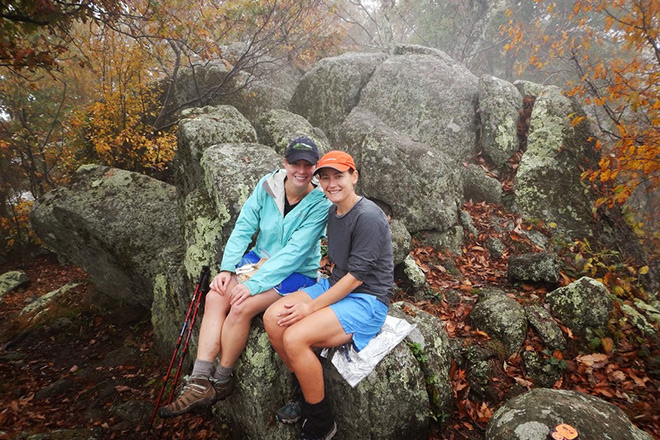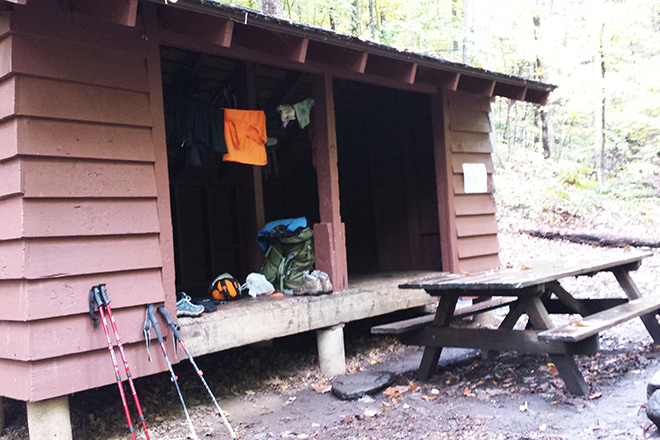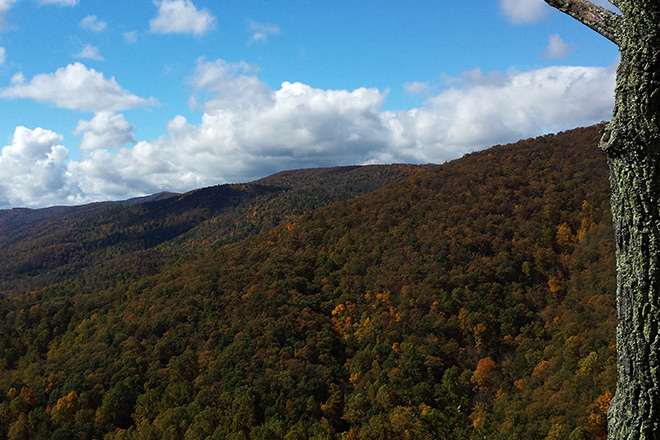Soon, the first signs of spring will arrive in Georgia. For some hardy souls, its arrival will be like a race’s starting gun, propelling them on a journey over mountains and across state borders.
These individuals are the Appalachian Trail thru-hikers. Though thousands of people walk this world-renowned trail each year, outdoor lovers exploring the East Coast don’t need to commit to spending months on foot and away from home to enjoy this spectacular trail and the unique community of hikers it attracts. You can go out for a few hours, a weekend, or a whole season. Last fall, I got a taste of life on the trail as part of a four-day trip with a thru-hiking friend.
Last September, I was one of seven smelly, cramped bodies setting up camp beneath a wooden shelter in The Priest Wilderness of Virginia. Overhead, the staccato sound of rain served as a soundtrack to the scene. I’d been on the trail for three days and was jonesing for a shower. Instead, my friend Ellen (trail name, Magellan) and I settled for a cup of hot cocoa and dry thermals in our sleeping bags. Drained from our uphill slog, covering about eight miles and 3,000 feet of elevation gain, I took a moment to absorb the orderly bustle around me.
A couple from California (Bigfoot and Bluejay), their nephew from DC, and his friend were laying out their sleeping pads, hanging up their rain jackets, and switching out wet socks for dry. Two southbound thru-hikers (K2 from Washington state and my friend Magellan from Texas) who had been on the trail since June resigned themselves to a low-mileage day on account of the weather. And then, there was me: a woman along for the ride, a weekender, a hobbyist.
What I realized on this fall weekend, surrounded by cloud-shrouded mountains and hooting owls, showy trees and sore muscles, is that the Appalachian Trail is the ultimate equalizer.
The people I met cannot be easily categorized. They are young and old, fathers and sons, singles and groups, mothers and aunts, businessmen and retirees, thru-hikers and day hikers, newly married and long married, old friends and new friends. And yet, out here, away from the normal strictures and labels of society, we are all the same, united under the banner of “backpacker.”
After meeting Magellan at a pull-off along the Blue Ridge Parkway, shouldering my pack, and staggering into step behind her on the trail, we shelter-hopped (hiking from shelter to shelter along the trail) to avoid tenting in the rain and suffering the ultimate hiker mistake: wet clothes. On the wooden platforms of the shelters, surrounded by three rough-hewn walls and a steepled roof, it can get intimate rather quickly. In what other setting do you find an assortment of strangers bedding down beside one another? I knew there was an etiquette on the trail (e.g., downhill hikers yield to uphill hikers), but there is an unspoken etiquette at the overnight sites as well.
Sweet treats and extra supplies are shared, not hoarded. Backs turn when newcomers arrive and shed wet layers. More experienced campmates assist novices in the cumbersome process of hanging food bags out of bears’ reach. Hushed voices accompany late night and early morning conversations. Headlamp beams remain lowered around others, and each person’s space—though limited to the width and length of one’s sleeping bag—receives absolute respect.
While there are stories of egos on the trail (folks who critique others’ knowledge, pace, or gear), I saw nothing but camaraderie. This is a temporary and fluid community of like-minded individuals who may lead wildly disparate “real” lives, but who escape to the woods and undergo a transformation, discovering a deep bond with their fellow hikers.
On the trail, information-sharing is common practice. Hikers generously provide details about upcoming water sources, locations of shelters and privies, weather forecasts, elevation gains, views to see, and campsites to avoid. For thru-hikers, whether “northbounders” ending in Maine or “southbounders” ending in Georgia, even more is exchanged: trail towns one shouldn’t miss, restaurants that provide specials like free doughnuts, hostels that include laundry facilities, “trail angels” who offer shuttle services, remedies for sore backs or blistered feet, and encouragement for everyday struggles like motivation and fatigue.
Considering the multitude of factors, like pace and trail length, it’s easy to think one would never cross paths with the same hiker twice. The opposite is actually true. Backpackers share updates and acquaintance sightings by word of mouth or via the journals stationed at each shelter, a little like passing notes or swapping gossip in a 2,000-mile-long high school. Hikers who walk together for a few miles one day may see each other again the following day or in a town three states away. Trail names, with their quirky flair, come in handy for this loose form of communication.
These names, which can be self-selected or supplied by others, may seem to the uninitiated like a nod to summer camp or the trail’s version of a Twitter handle. But after a few days listening to these names peppered throughout anecdotes and adventures, I realize they allow hikers to maintain their own oral histories. You might hear about Walkie and Talkie, Moxie, Brawny, Roady, Lemongrass, Chicken Fat, or Bonfire in a story-telling session whispered over a camp stove as people who were strangers only hours ago settle in side-by-side for another night on the trail.
Even though I only spent four days on the trail, I didn’t escape nameless. Whether she thinks I inspire dreary weather or merely survive it, my friend dubbed me “Rain Dancer.”
At the end of my time on the trail, my feet took me from the rock-strewn path back to the pavement, and back to the life I had vacated, if only briefly. Showered and rested, I felt a little nostalgic as I moved through my apartment, newly littered with the detritus of my adventure. Knowing the AT will always await Rain Dancer’s return, however, is reason enough to smile.
About the AT: The Appalachian National Scenic Trail snakes its way along the eastern United States, climbing and dipping for nearly 2,200 miles from Mt. Katahdin, Maine, to Springer Mountain, Georgia. Many sections of the trail are easily accessed from public roads and public lands, and hikers and backpackers can plan trips of every possible length, from day hikes to overnights to 6-month sojourns. On average, about 1,800-2,000 people attempt to thru-hike the entire trail each year.
Learn more about planning your own trip on the National Park Service, Appalachian Trail Conservancy, and Appalachian Trials websites.
About the author
-
 Katherine DeGroff Associate Editor
Katherine DeGroff Associate EditorKatherine works out of the Washington, D.C., office as associate editor of National Parks magazine. Before joining NPCA, Katherine monitored easements at land trusts in Virginia and New Mexico, encouraged bear-aware behavior at Grand Teton National Park, and served as a naturalist for a small environmental education organization in the heart of the Colorado Rockies.


